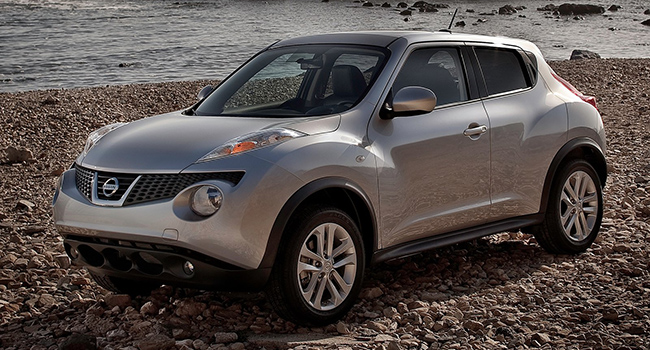
The 2011 Nissan Juke sported an interesting “D-mode” performance selector which allowed you to choose from Normal, Sport or Eco modes, The differences were obvious and immediate
 Introduced in mid-2010, the Nissan Juke was, to put it mildly, controversial. Some saw it as one of the homeliest cars to ever come down the pike, while others loved its idiosyncratic appearance and deviation from the norm.
Introduced in mid-2010, the Nissan Juke was, to put it mildly, controversial. Some saw it as one of the homeliest cars to ever come down the pike, while others loved its idiosyncratic appearance and deviation from the norm.
Built on Nissan’s B platform – also used for the Versa – the Juke came with one engine choice in 2011: a turbocharged/intercooled, direct-injection four-cylinder that displaced 1.6 litres and developed 188 horsepower. It was mated to either a six-speed manual or continuously variable transmission (CVT) and was available with front-wheel or all-wheel drive. It also required premium gas, although it would run on regular without any problems.
The all-wheel system splits engine torque between the front and rear driving wheels 50/50 when it’s in play, as well as sending it side-to-side across the rear axle. According to Nissan, this drivetrain offered fuel economy similar to that of their Sentra 2.0.
One interesting highlight was a “D-mode” performance selector. Located to the left of the steering wheel on the dash, buttons allowed you to choose from Normal, Sport or Eco modes. The engine throttle settings, suspension and transmission shift points were altered accordingly. The differences were obvious and immediate.
You could also choose “icon display modes” that let you, at the push of a button, change the instrumentation monitor display. Things like turbo boost, fuel consumption and even G-forces could be accessed instantly.
Also unique to the Juke was a motorcycle-inspired centre console. Apparently, Nissan’s designers took a long, hard look at various sport bikes and decided the profile of the fuel tank and rear fender would lend itself nicely to a centre console treatment and it could be highlighted in bright red paint. This was all done in an attempt to appeal to the info-oriented buyers in this market.
In terms of storage and cargo capacity, there was less room in the back than you’d find in the Juke’s stablemate, the Rogue, but more than a Volkswagen Golf or Mazda3, for example.
Two trim levels were initially offered: SV and SL, and a wide range of extras were available, including leather interior, heated outside mirrors, heated front seats, anti-lock braking, power moonroof, push-button start and a navigation system.
For 2011, there were two safety recalls from Transport Canada. One concerned a potentially serious leak from the fuel pressure sensor that could, if not attended to, result in an engine fire. The other involves a sensor from the turbo boost bracket. If it’s loose, it could cause the engine to lose power, although it could still apparently be driven for a short distance in its “fail-safe” driving mode.
The U.S. National Highway Traffic Safety Administration also had these two recalls on file, as well as 15 technical service bulletins. These range from a glitchy cruise control, to doors that won’t lock/unlock, to strange noises coming out of the engine compartment.
There were 15 complaints on file from owners:
- “total engine failure;”
- “car stopped because it was completely out of gas even though the gas meter read that there was more than a quarter tank of gas in the car;”
- “passenger side ball joints were detached from the frame.”
Consumer Reports didn’t give this one a particularly good rating. Serious issues with the fuel system, body hardware, and the inevitable squeaks and rattles translated into the worst used car prediction this organization can bestow.
Some comments from owners:
- “slow to warm up on cold days;”
- “gas mileage not what they say;”
- “performed better in the snow than my wife’s Grand Cherokee.”
From a price of just under $20,000 for a base SV with a manual transmission, the Juke these days is priced from $7,000 to $10,000. The all-wheel-drive version seems to be valued at $1,500 to $2,000 more than its front-wheel counterparts.
2011 Nissan Juke
Original base price: $19,998
Engine: 1.6-litre turbocharged four-cylinder
Horsepower/torque: 188/177
Transmission: Six-speed manual or continuously variable (CVT)
Fuel economy (litres/100 km): 7.3 city/6.1 highway (CVT), with premium gas
Alternatives: Kia Sportage, Hyundai Tucson, Mazda3, Volkswagen Golf GTi, Toyota Matrix, Scion xB
Ted Laturnus writes for Troy Media’s Driver Seat Associate website. An automotive journalist since 1976, he has been named Canadian Automotive Journalist of the Year twice and is past-president of the Automotive Journalists Association of Canada (AJAC).
For interview requests, click here. You must be a Troy Media Marketplace media subscriber to access our Sourcebook.
The views, opinions and positions expressed by columnists and contributors are the author’s alone. They do not inherently or expressly reflect the views, opinions and/or positions of our publication.

